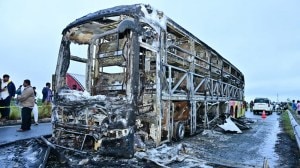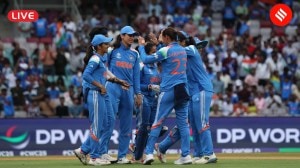Stay updated with the latest - Click here to follow us on Instagram
A life that was
It's the late 1940s. The construction of Rajghat,Mahatma Gandhis memorial,was on in full swing.
A photojournalist bequeathed boxes of Nehrus rare political,personal photos to a nephew who opened it 25 years later
It’s the late 1940s. The construction of Rajghat,Mahatma Gandhis memorial,was on in full swing. The then prime minister,Jawaharlal Nehru,had dropped in to oversee the work. Kulwant Royone of the early press photographers of Indiacaptured the moment when Nehru was seated in the middle of the construction materials,engrossed in a newspaper.
Ninety such rare and significant moments of the Indian history with Nehru in focus can be revisited at a week-long exhibition opening on November 3 at Discovery of India Building,Nehru Centre,Worli. All the photographs have been taken by Roy who has extensively photographed the events leading to the countrys independence as well as many rare moments post that. Most of these photos were taken between 1930s to early 60s. They are part of Indias visual history, says Satish Sahney,CEO of Nehru Centre.
Some photos,however,are an interesting departure from the most common image of Nehru in a pensive mood. The first PM of India is photographed with Govind Ballabh Pant on Holi at Teen Murti Bhavan; sharing a laugh with Jacqueline Kennedy during her India visit; and in cricket gear at a practice session.
Apart from chronicling and documenting the life and times of Nehru,these photographs also bring to fore the relentless efforts of Roy,who passed away in 1984,to capture the great moments of history. The photojournalist,who was a bachelor,bequeathed boxes full of these images to Aditya Arya. Nearly 25 years later,Arya opened to box to discover a trove of rare images of pre and post-independent India. All the photographs were systematically organised and annotated,negatives carefully packed together,notes painstaking scribbled at the back of fading photographs.
I was 24 when I inherited Roys photographs. But busy with my career as an advertising photographer,I hadnt opened those boxes. Now,we have set up a trust and are working towards creating a visual archive showcasing works of early photographers of India, Arya says. He remembers Roy recounting stories of photographing Nehru at dinner table.
Most prominent of them is about Roys overzealous assistant,who overloaded flash powder (which was used then to get the effect of flash). When Roy pressed the shutter,there was loud blastupsetting Nehru and other dignitaries present there.
Though for this exhibition features photographs of Nehru,there are nearly 10,000 important images left behind by Roy. These are crucial for creating Indias visual history. People quote text in historical context. But there are many rare photographs of the early 20th century which we are collecting to set up a visual archive, says Arya.







